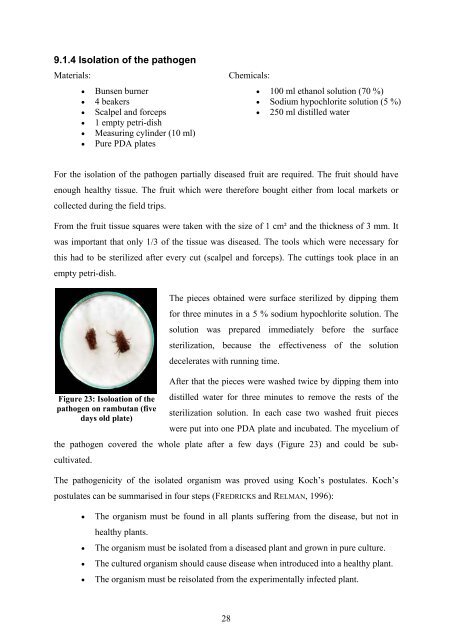Botryodiplodia sp. - Crops for the Future
Botryodiplodia sp. - Crops for the Future
Botryodiplodia sp. - Crops for the Future
Create successful ePaper yourself
Turn your PDF publications into a flip-book with our unique Google optimized e-Paper software.
9.1.4 Isolation of <strong>the</strong> pathogen<br />
Materials:<br />
• Bunsen burner<br />
• 4 beakers<br />
• Scalpel and <strong>for</strong>ceps<br />
• 1 empty petri-dish<br />
• Measuring cylinder (10 ml)<br />
• Pure PDA plates<br />
Chemicals:<br />
• 100 ml ethanol solution (70 %)<br />
• Sodium hypochlorite solution (5 %)<br />
• 250 ml distilled water<br />
For <strong>the</strong> isolation of <strong>the</strong> pathogen partially diseased fruit are required. The fruit should have<br />
enough healthy tissue. The fruit which were <strong>the</strong>re<strong>for</strong>e bought ei<strong>the</strong>r from local markets or<br />
collected during <strong>the</strong> field trips.<br />
From <strong>the</strong> fruit tissue squares were taken with <strong>the</strong> size of 1 cm² and <strong>the</strong> thickness of 3 mm. It<br />
was important that only 1/3 of <strong>the</strong> tissue was diseased. The tools which were necessary <strong>for</strong><br />
this had to be sterilized after every cut (scalpel and <strong>for</strong>ceps). The cuttings took place in an<br />
empty petri-dish.<br />
The pieces obtained were surface sterilized by dipping <strong>the</strong>m<br />
<strong>for</strong> three minutes in a 5 % sodium hypochlorite solution. The<br />
solution was prepared immediately be<strong>for</strong>e <strong>the</strong> surface<br />
sterilization, because <strong>the</strong> effectiveness of <strong>the</strong> solution<br />
decelerates with running time.<br />
After that <strong>the</strong> pieces were washed twice by dipping <strong>the</strong>m into<br />
Figure 23: Isoloation of <strong>the</strong> distilled water <strong>for</strong> three minutes to remove <strong>the</strong> rests of <strong>the</strong><br />
pathogen on rambutan (five<br />
sterilization solution. In each case two washed fruit pieces<br />
days old plate)<br />
were put into one PDA plate and incubated. The mycelium of<br />
<strong>the</strong> pathogen covered <strong>the</strong> whole plate after a few days (Figure 23) and could be subcultivated.<br />
The pathogenicity of <strong>the</strong> isolated organism was proved using Koch’s postulates. Koch’s<br />
postulates can be summarised in four steps (FREDRICKS and RELMAN, 1996):<br />
• The organism must be found in all plants suffering from <strong>the</strong> disease, but not in<br />
healthy plants.<br />
• The organism must be isolated from a diseased plant and grown in pure culture.<br />
• The cultured organism should cause disease when introduced into a healthy plant.<br />
• The organism must be reisolated from <strong>the</strong> experimentally infected plant.<br />
28

















